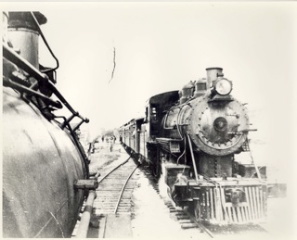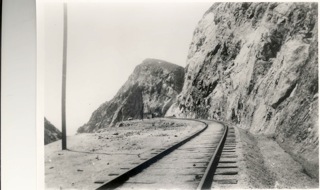A new-old story by June Morrall
Email June ([email protected])
[Image below: Expert? Are these Ocean Shore Railroad trains?]

The Ocean Shore was the First to Try to Conquer the Devil’s Slide
A new-old story by June Morrall (I wrote this in the 1990s)
It was a massive explosion high above the crashing waves.
In the early 1900s Ocean Shore Railroad engineers poured nine tons of black powder, pure dynamite into a 70-foot tunnel near Devil’s Slide. The powerful “bomb” blasted bits of rock and soil toward the sky—3,500 tons of mountainside—leaving the desired level grade for railroad ties at Saddle Rock.
The detonation was a remarkable feat in the struggle of man against nature. And the Ocean Shore Railroad proved to be a daring enterprise, far more courageous than their more conservative rivals, Southern Pacific, who operated a successful line of the flatlands of the Peninsula.
As a pioneer in Coastside transportation, planned to connect the isolated, rural farming community of Half Moon Bay with San Francisco, owing its growth to the 1849 discovery of gold. And the first major geographical obstacle, later called Devil’s Slide probably because it was a devil of a slide, sneaky and hard to control, appeared to have been conquered with then “high tech” dynamite.
But without warning the icy cold hand of nature struck back hard and fast as the trembled during the 1906 earthquake and fire.
At Devil’s Slide, where the work equipment was parked for the crews to install the iron rails, the ground lurched, and together with rolling, heavy rock boulders, the expensive tools and rails flew over the cliffs into the Pacific Ocean.

When the earth stopped shaking, an air of optimism returned, and a decision was made by higher-ups to continue with the railroad. Some lovely train stations were built, and the iron road reached as far as Tunitas Creek—-many miles short of the original goal, Santa Cruz, a popular recreational center.
Mother Nature had meted out her severe blow—but the curse was far from over—and she struck again and again at Devil’s Slide as the uncontrollable rocks tumbled down onto the tracks repeatedly.
Often the boulders on the tracks forced the train to back-up all the way to Pacifica, or to remain in place near Devil’s Slide until workers removed the obstructions.
“There were landslides from time to time,” recalled Rudolph Brandt sardonically (his father lost big bucks investing in the Ocean Shore). Brandt, an Ocean Shore Railroad aficionado, was an eccentric fellow who lived in the Tenderloin District of San Francisco when I met him. (I think I picked him up there and took him for a ride to the Coastside.) Brandt was the author of the booklet, “Ocean Shore Railroad.”
Said Rudolph Brandt: “The Pedro Point-Devil’s Slide area was a particularly bad section. In 1915 as a result of some powerful storms, about two miles of right-of-way track and all, caved off. Then they brought a train from the south, and the passengers got off the train, walked along the edge of the cliff until they got to the other train; this train then ran backwards all the way to Half Moon Bay and Tunitas.”
The rock slides spoiled the railroad’s ambitious plans, but lively passengers could also turn an unexpected delay into a good excuse for an evening of celebration and drinks in places like the resorts of Princeton and Pacifica, depending on where the train that was running on the boulder-less tracks took them.
“One time the train was heading back to the city, with a whole bunch of people on it when, around Point Rockaway, a big boulder came down, right on the tracks,” recalled Brandt. “The engineer saw it, and they stopped, but they couldn’t get the boulder off the track. Train’s crew decided to back the train to Pedro Valley. And they backed it down there right in front of Danman’s Place, the old saloon there. The [passengers and the engineer] spent the night in there, eating, drinking and making merry. I understand they practically cleaned the place out, as far as booze and grub went.”
California may have more topographical features named for the “Prince of Darkness,” [ed. Devil’s Slide]than any other state, yet it is difficult for me to pinpoint exactly when Devil’s Slide acquired its name.
An 1881 map calls the nearby area Saddle Rock—perhaps the name came about during the Ocean Shore Railroad era.
In any event, the railroad was losing money, partly due to the cost of continued maintenance of the road at Devil’s Slide—and, more importantly, because Coastside farmers preferred to buy trucks with rubber tires that carried their fresh vegetables to market on a timely basis. [Remember when the trains were delayed, the fresh vegetables, including artichokes, wilted and lost their value.]
Finally declaring bankruptcy, the Ocean Shore pulled up its rails about 1922, and the State of California, using its right-of-way developed plans for the building of the Ocean Shore Highway, today called Highway 1. Hundreds of feet above the Pacific Ocean, a new roadbed was carved into the cliffs, and the Coastside’s sole north-south link opened about 1933 –during the Great Depression, and the repeal of Prohibition.
Construction moved slowly as Devil’s Slide challenged the workers again. The unstable soil continued to cause landslides, while the crews worked, knowing their lives were in danger. It was not uncommon for thousands of tons of rocks and earth to suddenly loose and slip down the mountainside, burying steam shovels and other equipment. The 5.9 mile rod required 28 curves with a total rise and fall in grade of 1, 225 feet, according to “The Coastside Highway 1 Book,” written by Rick Adams and Louise McCorkle.
“The location of the highway along the cliff face required men with the agility of mountain goats, courage, and the complete lack of nerves. One false step meant a tumble into the breakers,” according to the June 1937 issue of “California Highway and Public Works.”
A new-old story by June Morrall
